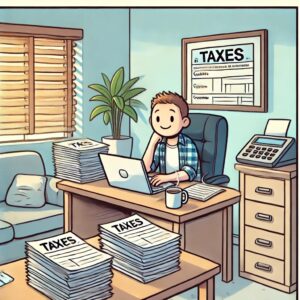By: Brian Solis for the MIT Sloan Management Review, Photo by Glenn Carstens-Peters on Unsplash
To regain focus in an ever-distracting digital world, managers must not only give employees tools and training but also model the right behaviors themselves.
As an analyst and adviser to tech companies, I’ve long known the tricks that digital platforms use to get people addicted. I didn’t think it would happen to me. But a few years ago, I fell into the trap.
Throughout the day, I could barely go a few minutes without checking notifications on my phone. My productivity suffered, as did my relationships and life outside of work.
The digital distraction trap happens in businesses across all industries and affects workers of all age groups. It’s taking a toll on worker well-being. A 2012 study estimated that digital distractions cost businesses more than $10,000 per worker per year. According to a more recent report from Udemy, nearly two-thirds of workers (62%) spend about an hour of each workday looking at their phones.
The survey found that most employers are lagging when it comes to helping employees “manage the constant barrage of noise, interruptions, and notifications in order to maintain performance.” Seventy percent of workers say training would help people block out distractions. But 66% have not spoken to their managers about the need for this training, “perhaps because they feel insecure about revealing areas of perceived weakness.”
In my book Lifescale, I share a series of steps that helped me regain my focus. I’ve also found that when those of us in management roles share best practices with our teams, the results can be transformational and have exponential effects across an organization, helping to instill a healthier, more focused work environment.
Teach the Pomodoro Technique. Starting off with strict rules such as “no looking at your phones for the next hour” won’t do much for long-term improvement and may build resentment rather than engagement on teams. We’ve been trained like Pavlov’s dog to respond to our notifications and even anticipate them. Often, we don’t even realize we’re doing it. The key is for us to unlearnthis response, so we can start letting those impulses go.
One way to help unlearn these reactive practices and make better use of uninterrupted periods of time is to use the Pomodoro Technique. The goal is to focus on a single task for 25 minutes, followed by a break of about five minutes. Since you know that a break is coming, it’s easier to resist the urge to check each notification that pops up or become distracted by nonwork-related tasks.
Some may adapt quicker to these time-blocked efforts than others. I had to start with much shorter blocks of time, working my way up to 25 minutes. Challenge your employees to do the same. Offer them a space to store their devices out of reach. Encourage them to check out apps that show them how often they pick up their phones throughout the day.
If you receive pushback, lead with empathy. Emphasize that you’re in it together — after all, we’ve been conditioned by technology in recent years. But with this approach, individuals and teams can get more work done by focusing for set periods of time. You can also offer to tell other departments and even clients that “this is how we work now,” so that they can expect email replies within two hours rather than two minutes, but that in the end, this will be a better way of working for all parties.
Turn the clock back on open offices. While the post-dot-com era has seen an explosion of open office plans, with many organizations literally breaking down office and cubicle walls to create more open spaces, recent research conducted at Harvard Business School has found that open office plans can actually be highly detrimental to productivity and collaboration.
While it’s good for offices to include open areas in which people can talk and collaborate, it’s also important to give workers their own spaces away from all the noise. In fact, in Udemy’s survey, workers cited chatty coworkers and office noise as even bigger problems than digital distractions.
But even digital distractions are made worse by open offices. After all, you can turn off your own phone, but it won’t stop you from hearing all the beeping and buzzing of everyone else’s devices from across the room. And hearing those notifications can add to the temptation to abandon the work at hand and check your own.
When possible, I encourage managers to provide people not just with cubicles, but with offices (whether it’s individual offices if possible, or shared quiet rooms). The ability to close a door makes a big difference. And providing employees with noise-canceling headphones is also a great solution — not only because they can block out sounds, but also because they send a physical reminder to others not to interrupt colleagues when they’re doing focused work.
Establish a plan for urgent situations. Even if people manage to reduce tech addiction and work in quiet conditions, they still often rightfully feel the need to check every digital notification just in case it’s urgent.
I recommend managers set up a protocol exclusively for urgent messages — and use it sparingly. This could be a tool that emits a special sound when something is marked as urgent. An easy-to-use setting on computers, phones, and tablets can block out all other notifications, allowing only urgent messages through. I recommend making it possible for anyone in the organization to mark an email as urgent, rather than having all emails from certain senders (such as your boss) show up as urgent.
And when people are on vacation, don’t expect them to see email at all. If they absolutely must be contacted in an emergency, text or call them.
Model best behaviors. Ultimately, one of the most powerful things we can do as managers to fix distracted working conditions and restore productivity is to engage in the right behaviors ourselves.
During staff meetings, those of us in leadership positions should make it standard practice to avoid looking at our emails, Slack messages, or anything else on our phones. When we chat with employees, we should not assume they’ve already seen non-urgent emails that we sent them in just the previous hour. And when we’re sitting (or standing) at our desks, employees should see us focusing, uninterrupted, for substantial periods of time.
It isn’t easy. Accomplishing all this means going against the grain of how our offices have evolved in recent years. But I know from experience that when we take these steps, our work lives become better — and our businesses more successful.
Read the original article here. Sign up for our newsletter here.




